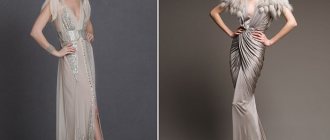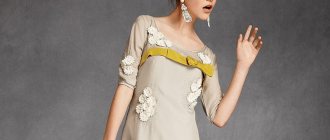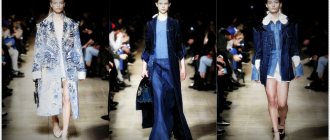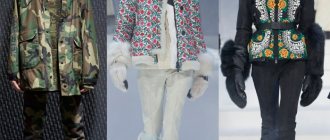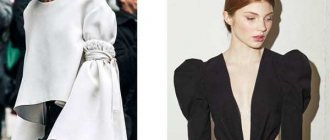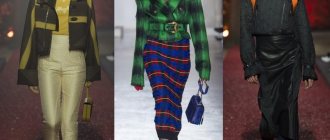Today, July 5, the oldest and most revered Fashion Week begins in Paris, where couturiers amaze viewers with their boundless imagination - haute couture. Guests of high fashion shows flew to the moon (for example, for the Chanel fall-winter 2021 show, the Grand Palais turned into a space station) and were transported back 3,500 years (during the presentation of John Galliano's spring-summer 2004 collection for Dior, inspired by Ancient Egypt) .
What is haute couture
The trend of haute couture (literally “high sewing”) appeared at the end of the 20th century in Paris, and this is fashion in all its grace. “Couture has no equal in terms of creativity, it is simply a fantastic laboratory of craftsmanship and innovation in design,” Ralph Toledano, president of the French Federation of Haute Couture, Prêt-à-Porter and Fashion Designers (Fédération de la Haute Couture et de la Mode), told Vogue in Last year. “It’s an incredible freedom of expression for designers and a means of maintaining an image for brands.”
What is haute couture in a rapidly changing world?
Last week, couture shows of key fashion houses took place in Paris and Rome. Elena Stafieva reflects on the future of haute couture and the fact that high fashion has long ceased to be a laboratory for the birth of new ideas
Every haute couture season goes the same way: 10 collections are shown (5 of which are worth discussing), and then everyone starts talking about the fate of couture. And at the center of this conversation is always its definition - what is haute couture in the middle of the second decade of the 21st century? Is it art, a laboratory of ideas or just a marketing tool for promoting perfumes and accessories? Judging by the fact that these questions are repeated year after year, there is a gap where the answer should be. That is, it simply does not exist.
Perfumes and bags always come up when talking about couture: everyone always remembers them in one way or another. Indeed, you shouldn’t vulgarize couture and reduce everything to selling perfume, just as you shouldn’t hypocritically say: “Don’t think about it, we’re making art here, not selling bottles.” For example, Jean-Paul Gaultier, closing his prêt-à-porter line a year ago, formulated his future as follows: to focus on haute couture and develop a perfume line.
High fashion, indeed, at some point at the turn of the last and present centuries began to look like an extremely expensive anachronism, and in search of its practical justification, such a concept arose - yes, it is expensive and costly, but it helps to sell everything else. This is actually an effective marketing mechanism - and not even the most expensive in modern times. But this alone obviously does not seem to be a sufficient justification for haute couture.
Some time ago, they started talking about couture as a laboratory of ideas as opposed to prêt-à-porter, which is under constant stress of rising sales and ever-faster updates in the modern world of Instagram. Yes, maintaining and developing rare craft decoration techniques, yes, experiments with textiles, but let's remember what new design ideas, important trends and simply advanced forms and technologies have appeared in couture since the beginning of this century? To be completely honest, the last time Parisian couture was a laboratory of ideas was in the 60s of the last century. Well, okay, back in the 70s. And then he increasingly declined and almost died in the 90s. The space of ideas today is anywhere, but not in haute couture.
Separating couture from the world, opposing it to all other fashion, influenced by social networks and the streets of big cities, and pushing it into an ivory tower in every possible way is not the most productive way, like any opposition to modernity. I think Cristobal Balenciaga would be very surprised if he knew that his dresses for Bunny Mellon, Mona von Bismarck and Grace Kelly are a laboratory of ideas. Yes, over half a century a lot of things have changed in the most radical way, but today the most successful couture lines are traditional, completely conventional beauty with lace, embroidery, appliqué, crystals and trains. As the experience of the newest Valentino shows, you can build a successful couture business around, in fact, one single, simplest dress model, varying it in every way with intelligence and imagination.
To be completely honest, the last time Parisian couture was a laboratory of ideas was in the 60s of the last century. Well, okay, back in the 70s. And then he increasingly declined and almost died in the 90s. The space of ideas today is anywhere, but not in haute couture
Of all that was shown at the just-closed haute couture week, it was only possible to talk about shapes, proportions and design ideas in general in relation to Dior by Raf Simons. In 2015, you can’t seriously consider mesh dresses, blanket dresses, and burlap dresses, as shown by John Galliano, to be fresh ideas. Eccentric - as much as you want, but we have already seen it all, including Galliano himself about 99 times. Just like the extravagant fur fantasies of Karl Lagerfeld were seen back in 1977 in Jacques de Bascher's film Histoire d'Eau, dedicated to Fendi.
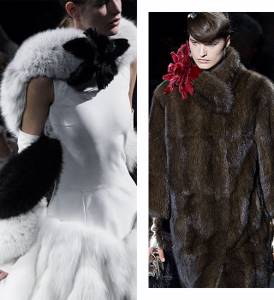
A convincing answer to the question of what couture is today is given by the exhibition The Fashion World of Jean Paul Gaultier, which takes place in the Grand Palais in Paris. The queue for it is noticeably longer than for the Velazquez exhibition, which has been running for literally the last few days in the neighboring wing of the same Grand Palais. Art or fashion? For the people who stood in this line, fashion is obviously a more important art than Velasquez. But art is of a completely different kind. This is modern art.
Like any modern art, fashion is closely connected with entertainment, that is, with entertainment. At any exhibition of contemporary art, something must shine, move and come into direct contact with the viewer: the public must be attracted and captivated, without this there is no way now. The mannequins at the Gaultier exhibition smiled, rolled their eyes and kept turning to the viewer (special projection), and most of all Gaultier himself in a mink sailor suit and a red scarf around his neck. This caused childish delight among the public - it was impossible to squeeze through to Gautier who was speaking, everyone was filming videos for Instagram and Facebook (fortunately, the Grand Palais, like all advanced centers of contemporary art, now has free Wi-Fi). Couture is entertainment for the public who wants to see something outlandish, something incongruous, something extravagant, in which, in fact, there is nothing revolutionary, nothing original, no challenge. Gaultier's talking mannequins are the kind of entertainment where every couture outfit (and there is noticeably more haute couture than prêt-à-porter) has a sign indicating even the working hours spent on it. Karl Lagerfeld understands this just as well - each of his next couture shows has an increasingly complex scenario: from the supermarket to the casino and then everywhere.
The Fashion World of Jean Paul Gaultier exhibition also perfectly comments on the theme of shock, awe, crazy ideas and haute couture in general as a laboratory of ideas. Everything was already there: dresses made from garbage bags, men in corsets made of satin and feathers, all kinds of BDSM and brothel aesthetics, and even more so mesh of all sorts and types. All this has already happened even in the space of one career - Jean-Paul Gaultier. Any extravagance has already been used and worked out - how can it still shock someone and give rise to new ideas?
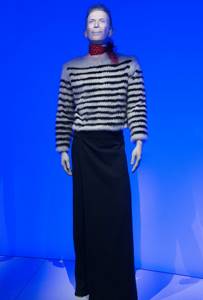
At the same time, Gaultier's things look historical. You see black leather, garbage bags, metal and you think: Sex Pistols, punk rock, 70s (really, 1977). You see corsets and latex and you understand: Madonna, cone-shaped bras, the aggressive sexuality of the second half of the 90s (however, Gaultier still hasn’t parted with underwear). And all these outfits look much less futuristic than the dresses of the main genius and futurist of all times, Cristobal Balenciaga.
And if fashion is art, then this is exactly what it is - modern and mass. You can, of course, place dresses among sculptures and paintings, and it can be mesmerizingly beautiful, but the future of couture is more likely to lie in Gaultier's talking mannequins than next to Bernini's sculptures. Well, new clients from the Far East, whom everyone is waiting for with hope and hope. And while the wives and daughters of Chinese billionaires take their places in the front rows of haute couture shows, Rihanna orders a dress in the style of wild Asian luxury from Chinese couturier Guo Pei. So the future, as always, has different scenarios.
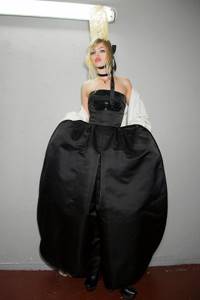
Fashion
Haute Couture
Art
designers
Chambre Syndicale de la Haute Couture
Backstage at the Christian Dior Haute Couture show It is the regulatory body that determines which fashion houses have the right to produce Haute Couture collections.
The Chamber is also called upon to monitor compliance with copyrights for high fashion collections, monitor piracy, and coordinate high fashion shows. The School of Designers operates under the auspices of the chamber, training craftsmen and fashion designers for high fashion. Since the 1980s
Some brands have mistakenly acquired the reputation of high fashion houses. This is partly due to the fact that at that time many houses had both ready-to-wear (ready-to-wear) and Haute Couture collections. Falling incomes and economic problems have forced many houses to abandon the creation of haute couture collections, switching exclusively to "ready-to-wear". These houses are no longer considered Haute Couture, although the general public may call them that.
In 2012
The official members of the Chambre Syndicale de la Haute Couture were: Adeline André—Atelier Gustavolins—Chanel—Christian Dior—Christophe Josse—Franck Sorbier—Givenchy—Jean Paul Gaultier—Maurizio Galante—Stéphane Rolland.
Corresponding members (or foreign members) were: Elie Saab, Giorgio Armani-Giambattista Valli, Valentino, Versace.
Guest members of the chamber: Alexandre Vauthier—Bouchra Jarrar—Iris Van Herpen—Julien Fournié—Maxime Simoens—Yiqing Yin.
High fashion jewelry houses: Boucheron—Chanel Joaillerie—Chaumet—Dior Joaillerie—Van Cleef & Arpels.
High fashion accessories: Loulou de la Falaise—Massaro—On Aura Tout Vu.
Haute couture: secrets and myths of high fashion
The fashion designer was the first to organize shows where he showed the clothes he created. They were held 4 times a year, in accordance with the seasons. At these shows, clients chose the models they liked, then the fashion house sewed them taking into account the client’s specific sizes, from the fabrics she wanted.
Thanks to Charles Worth, tailors acquired the rank of couturier, and tailoring became an art.
Requirements for high fashion products
Now the High Fashion Syndicate is an association of fashion houses that dress the secular and financial elite of society. It includes leading Parisian fashion houses. Their goal is to develop collections of unique exclusive models, made in one copy for people seeking to emphasize their wealth, individuality and high social status.
The number of high fashion houses may vary, but, as a rule, there are no more than 20 (give or take). The title of “couturier” can only be worn by a member of the Syndicate. The organization strictly monitors compliance with copyright in the field of fashion and prohibits copying copyright models.
To join the Syndicate, you must meet strict requirements. First of all, tailoring must be done largely by hand. Charles Worth did not recognize factory-made things; he believed that handmade guarantees the uniqueness of things and their high quality. Since then, this requirement has not changed; until now, the number of machine seams should be no more than 30% (!). You also need to have a high turnover, several boutiques in Paris, etc.
Employees of high fashion houses have a narrow specialization: some are exclusively engaged in embroidery, others work with feathers, etc. This ensures a high level of professionalism. The average number of employees is 5,000, with 2,000 seamstresses.
Each item takes from 100 to 400 hours of work (!). At the same time, at least three fittings are done, thanks to which the item fits perfectly and improves the figure.
Cost of high fashion products
Haute couture items are incredibly expensive. For example, for a dress made in a high fashion house you will have to pay from 25,000 to 100,000 thousand dollars, for a suit - from 16,000 dollars, for an evening dress - from 60,000 dollars.
Ready-to-wear
Prêt-a-porter (translated as “ready to wear”) are models launched into mass production by high fashion houses. Unlike haute couture items, which are created in a single copy, ready-to-wear clothing is replicated. The series are made small, and items are sold in branded boutiques.
Such ready-to-wear collections serve as an important source of income for fashion houses. Ready-to-wear items are much cheaper than items made in high fashion houses.
In passing, I would like to note that there are companies focused on the mass market and not related to the High Fashion Syndicate, but who can very successfully combine the latest fashion trends with affordable prices. Among them, the world-famous brands Zara and Mango are leading.
Who are the clients of high fashion houses?
For high fashion houses, the “golden” time was the years after the end of World War II. Then this industry developed rapidly. But even at that time, only 15,000 clients could afford to order clothes from fashion houses from the best couturiers.
Currently, the number of such women has decreased significantly: approximately 2,000 representatives of the fair sex order clothes there. Well, only 200 people are regular clients of these houses.
How do high fashion houses make money?
Fashion houses have a small clientele, but at the same time they have a huge staff using manual labor. Given these factors, making unique, exclusive clothing items brings very little profit.
However, there is another important factor. Fashion houses make great efforts to create a famous brand and a big name, but they make money on something else. Their main profit comes from perfumes, cosmetics, tights, and exclusive jewelry.
Most women are not able to buy themselves a haute couture or ready-to-wear dress. But many of them can buy eau de toilette, lipstick, tights from the famous fashion house and at the same time feel like they are part of the world of luxury and luxury.
Why are high fashion shows held?
They are necessary to attract attention. This luxurious, colorful spectacle is the best advertisement for high fashion houses. Shows are an expensive undertaking, but they allow fashion houses to improve their image, raise their prestige, and attract not only haute couture clients, but also buyers of mass products.
Interesting facts and rules of Haute Couture
I often hear surprise and rejection of Haute Couture. Who needs this? For what? Where to wear it? Is this fashion for crazy people? And only a few know that high fashion is nothing more than the highest artistic skill in fabric, the use of only manual labor, only the highest flight of imagination, only the best fabrics.
Haute Couture is comparable to the Nobel Prize ceremony, or it can be compared with the paintings of Van Gogh, Claude Monet, Edgar Degas, Renoir, with great musicians - Mozart, Beethoven, Bach, etc. Approximately 2000 people in the world can afford to wear haute couture clothes . Therefore, we can talk about the profitability of couture only conditionally; you can’t balance debit and credit with two thousand. All this is paid for by sales of bags and perfumes - as was the case back in the 1990s.
Haute Couture is quite an expensive business, since at the request of the fashion syndicate, only up to 35% of machine stitches are allowed in a couture product; sewing one model takes from one hundred to five hundred hours, respectively, only the salary of the craftswomen, you can imagine how high it is, not counting other expenses. Some brands, on the contrary, pay tribute to tradition and prefer to do everything completely by hand the old fashioned way. Everything depends, of course, on the well-being of the brand, since it is too expensive to do everything manually and also pay for the display. Participation in a haute couture show costs more than 100,000 €.
Each couture model has its own number, since it is made in a single copy by hand without the use of patterns; the shape of the future outfit is given to the fabric with pins, then marks are applied to the pinned areas and cut according to them.
The duration of the work, the cost and quantity of fabric, the use of embroidery, batik and other methods of decoration determine the cost of a couture dress, which for all models is very high: I repeat that no more than two thousand customers around the world can buy them, the bulk of whom live in United Arab Emirates and Russia.
Since Haute Couture is quite an expensive business, couture studios are closing. For example, in 2002, when the Yves Saint Laurent couture studios were closed, they said that with the departure of Yves Saint Laurent, high fashion died. And now it’s been 11 years since she continues to die, and it’s still not clear whether the patient is more likely alive or more likely dead.
Gradually, old houses disappear from the couture week schedule, but new ones appear. There is also a very practical explanation for this: it is almost impossible to get into the prêt-à-porter week schedule, it is packed to capacity, but there is plenty of space in the couture section.
I hope that Haute Couture will not die, as it is the highest level in fashion, a laboratory of ideas for pret-a-porter and mass market. They use the developments and ideas of high fashion, adapting them for profit and mass production; couture sets the tone for pret-a-porter and the mass market for several years to come. Haute Couture is the highest level of craft that can support the creation of inexpensive, but fashionable and high-quality clothing for the masses.
By the way, the concept of haute couture does not apply to men's fashion.
7 rules of Haute couture
1. You buy a couture dress not because you like it, but because there is a specific reason to wear it.
2. It is decent to bring it “out into the world” only once, no more. If you really like it, then two, but the second release should take place no earlier than in 10-15 years, so that it can rightfully be called vintage.
3. It is indecent to buy a girl’s first couture dress before she turns 16. This is etiquette.
4. This outfit is sewn directly to the customer’s figure. At least three fittings will be required.
5. From the moment of purchase until the dress is delivered to the client, up to three months can pass. And no one is nervous, everyone is waiting with hope.
6. All fabrics used by the House to create couture collections necessarily bear an exclusive print of the house, which will never be used by anyone else.
7. A couture dress requires special accessories, such as family diamonds.
What is Haute Couture?
Although such a concept as “haute couture” is known to many, some still do not fully understand what it means, much less what it is needed for in general.
In order to find out how “haute couture” was born, what has the right to be called “haute couture”, and how it influences fashion in general, you need to go to Paris, and only to Paris, because that’s where Parisian fashion exists . High Fashion Syndicate.
Haute couture originated in the mid-19th century, when the first fashion salons began to appear.
English fashion designer Charles Frederick Worth captivated Parisian society with his masterpieces. His luxurious products were rated so highly not only because of the expensive material, handmade work and excellent execution. Each Worth masterpiece was signed by the master himself, and the road to high society was open to the lady who wore such a dress.
In 1868, the Paris Committee of the Garment Industry Trade Union was created, and already in 1943 a law was passed according to which “haute couture” fashion designers received equal rights with literary and artistic workers.
What creations of fashion designers have the right to be called “haute couture”.
According to the Paris Syndicate of Haute Couture, haute couture products must be at least 70% handmade. This is mainly achieved using embroidery and appliqués. All products are made from fabric specially made for them, which is extremely expensive and of high quality. This is why haute couture items are so expensive.
Each Fashion House has a staff of artisans, the number of which must be at least 20 people.
Thanks to the work of these highly qualified specialists, unique lace, pleating, decorations, buttons, costume jewelry and other accessories are produced.
It can take approximately 100-150 hours of intense manual labor to create one outfit.
Creating an evening dress with embroidery requires several thousand hours of manual work. Twice a year, the Fashion House is obliged to present to the international press a show of at least 50 haute couture models.
Typically, Haute Couture Weeks avoid any connection with ready-to-wear shows, although they are presented by the same houses. Shows take place in January and July, usually at the Croiselle du Louvre complex.
High Fashion Weeks are attended by the richest and most famous people in the world, who can easily afford to buy a dress for 100 thousand dollars or even more.
To obtain haute couture certification, a fashion house must be located in the capital of France.
Belonging to a Haute Couture House is protected by law, and the list of Haute Couture Houses is compiled by a special commission under the French Ministry of Industry.
Foreign Couturiers can only be corresponding members of the Syndicate.
So, for example, the fashion houses of Versace and Valentino may be invited to High Fashion Week, but due to the fact that they do not meet all the criteria, they are not called “haute couture”, but simply “couture”. Why do you need “haute couture”?
I’m sure many people have asked this question, because most of the outfits are absolutely unwearable, and due to their astronomical price, they are also out of reach!
The whole point is this: the hype and showiness of this kind of event provides an excellent opportunity for designers to raise the image of their homes and attract as many clients as possible.
Haute Couture weeks are followed by Ready-to-wear shows, which generate the main income. Seeking the luxury, glitz and glamor seen at Haute Couture shows, admirers of the designer’s talent are buying up his ready-to-wear collections.
And of course, Haute Couture prepares a springboard for ready-to-wear creations; it is from there that designers draw new ideas, images, colors and silhouettes.
Celebrities are happy to show off their haute couture outfits on the red carpet.
Dior Haute Couture Spring 2010
Chanel Haute Couture Spring 2010
Valenyino Haute Couture Spring 2010
Jean Paul Gaultier Haute Couture Spring 2010
Givenchy Haute Couture Spring 2010
Elie Saab Haute Couture Spring 2010
High fashion - “the business of image”, or Everything we know about Haute Couture
Not so long ago (a month ago) Paris Haute Couture SS 2016 ended, which prompted me to write this article. To remember everything that I personally know about “High Fashion” (with excerpts from lectures at the Academy on the history of costume, preserved in my memory), and also to use the greatest invention of our era - the Internet, and collect everything into a single picture.
Literally translated from French, Haute Couture means “high sewing.”
Nowadays, this refers to the creation of high-end clothing and is translated as “high fashion.”
The center of haute couture, as you might guess, is Paris, where the Chamber (Syndicate) of Haute Couture is located. She determines the status of fashion designers, organizes shows of collections of high fashion houses, and maintains relations with the press and stores around the world.
To be classified as a Haute Couture House, you must meet a number of requirements:
1. All production - the central atelier, workshops, shops - everything should be located in Paris.
2. The house must have at least 15 employees (in different sources this figure can vary up to 20) and present collections 2 times a year - in each fashion show there are 35 dresses “for day and evening”. In 2001, the rules for admission to the Chamber were simplified.
In 2001, the following Houses included:
- Balmain;
- Chanel;
- Christian Dior;
- Christian Lacroix;
- Emanuel Ungaro;
- Givenchy;
- Hanae Mori;
- Jean Louis Scherrer;
- Jean Paul Gaultier;
- Lecoanet Hemant;
- Louis Feraud;
- Thierry Mugler;
- Torrente;
- Yves Saint Laurent;
- Viktor&Rolf.
Houses whose central ateliers are located outside Paris are corresponding members of the Chamber. So, for example, the fashion houses Versace and Valentino can be invited to High Fashion Week, but due to the fact that they do not meet all the criteria, they are not called “haute couture”, but simply “couture”.
The number of high fashion houses varies, but almost always stays around 20.
The haute couture house generates profits of over a billion dollars annually and employs approximately 5 thousand people, including 2 thousand seamstresses.
As a rule, employees have a narrow specialization: some of them work with feathers, some with embroidery, some with buttons.
Haute couture dresses are often made by hand and in only one copy. According to the Paris Syndicate of Haute Couture, couture products must be at least 70% handmade.
Each model usually requires from 100 to 400 hours of work. The suit or dress chosen at the fashion show is only a sample, and a new one is sewn for the client, ideally suited to the figure (at least 3 fittings). Therefore, the price of a haute couture dress is high - from 26 thousand to 100 thousand dollars, a suit - from 16 thousand dollars, and an evening dress - from 60 thousand dollars.
During the “golden” years of haute couture - after World War II - approximately 15 thousand women could afford to wear dresses made by the best craftsmen in Paris.
Today, on average, 2 thousand women (!) order haute couture clothes, and the number of regular clients of high fashion houses is even less - about 200!
High fashion brings very little profit to fashion houses. In fact, they often even make losses. Enormous costs and a very small clientele may explain why the number of haute couture houses has declined significantly over the past sixty years.
Why do you need “haute couture”?
This is pure “art for art’s sake.” It's all about "performance" (theatrics), showiness and hype. These types of events provide an excellent opportunity for designers to raise the image of their homes and attract as many clients as possible. After the Haute Couture weeks come the Prêt-à-Porter shows, which generate the main income.
Many famous fashion houses first develop unique clothes, then the best ideas are adapted in factories. After this, work begins with large companies, with production, with textile manufacturers, in order to adapt this idea, to use it economically, so that there is at least a small flow, and people can see these clothes not only in magazines and on the catwalk, but also in stores and boutiques
Interesting Facts
In 2005, Giorgio Armani, surprising many fashion industry analysts, launched his Haute Couture line - Armani Privé. This idea seemed doomed from the very beginning: if Versace and Ungaro refuse to show Haute Couture, what does Armani, who has never done haute couture and built his empire on casual classic jackets and trousers, expect? However, the 70-year-old designer said there was a demand for dresses with a $10,000 price tag, and he was right.
The first Armani Privé collection turned out to be completely wearable and as if created for various high-level social events. Despite the seeming “mundane” nature of the Armani Privé line, every item in it is hand-sewn, which takes two months, and the price goes through the roof for 10,000 euros. The bet on super-luxury turned out to be correct: every season the designer’s European clients order an average of 3 ensembles from the Armani Privé line. In addition, Armani sends its head seamstresses to perform fittings directly to clients who order several dresses per season.
The house of Chanel does the same, paying its head seamstress for private jet flights around the world. After all, many of the serious haute couture clients are not present at the fashion shows, which are covered by a large amount of press. Instead, they are sent a DVD with a recording of the show, or a password to view the new collection on a special website.
Also, especially for haute couture clients, fashion houses hold private shows in showrooms somewhere in New York.
The house of Versace quietly presents its couture evening dresses to customers at its showroom in Paris. In addition, fashion houses began holding shows of their couture collections in New Delhi or Hong Kong, reasoning that if their new potential clients could not or did not want to come to Paris for this, they should bring the collections to their homes.
Representatives of the Valentino house say they regularly fly to Moscow and Dubai to meet with clients, since only 10% of their clients purchase couture items in the Paris showroom.
In November 2007, Crocus Group opened Russia's first exclusive Atelier Couture in the Crocus boutique (Stoleshnikov lane, 5).
And in December 2007, Italian couturier Lorenzo Riva visited Moscow to show his new 2008 collection and communicate with Russian clients.
P.S
High fashion is the “business of image.” And the fashion weeks held periodically are points of inspiration. At their core, these are advertising campaigns - the largest of all. They help both beginners and famous designers express themselves and show their creativity to the world - after all, this is the main goal of their work. And these events are the most effective way to tell about yourself. Of course, millions of euros are spent on them, but for designers, as true artists, showing at Fashion Week is a way of self-expression, a “canvas for creativity” where you can create anything.
And in conclusion, I would like to quote the amazing Ralph Loren: “Fashion is not about labels. And not about brands. It's about something else that's going on inside of us."
